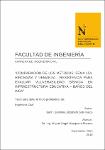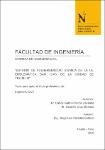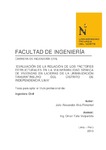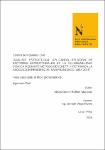Mostrar el registro sencillo del ítem
Comparación de los métodos: fema 154, hirosawa y demanda - resistencia para evaluar vulnerabilidad sísmica en infraestructura educativa – Baños del Inca
| dc.contributor.advisor | Mosqueira Moreno, Miguel Ángel | |
| dc.contributor.author | Soto Raico, Edelmira Elizabeth | |
| dc.date.accessioned | 2018-06-29T02:31:11Z | |
| dc.date.available | 2018-06-29T02:31:11Z | |
| dc.date.issued | 2018-06-20 | |
| dc.identifier.citation | Soto, E. E. (2018). Comparación de los métodos: fema 154, hirosawa y demanda - resistencia para evaluar vulnerabilidad sísmica en infraestructura educativa – Baños del Inca [Tesis de licenciatura, Universidad Privada del Norte]. Repositorio de la Universidad Privada del Norte. https://hdl.handle.net/11537/13477 | es_PE |
| dc.identifier.other | 624 SOTO/C 2018 | es_PE |
| dc.identifier.uri | https://hdl.handle.net/11537/13477 | |
| dc.description.abstract | El presente trabajo se enfocó en comparar los métodos FEMA 154, Hirosawa y Demanda – Resistencia, mediante la cual se estableció el método más conservador para evaluar vulnerabilidad sísmica de una infraestructura educativa. Para ello se tomó como muestra un módulo del colegio Andrés Avelino Cáceres ubicado en el distrito de Baños del Inca (zona 3 según E-030). La evaluación por el método FEMA 154 (Evaluación Visual Rápida) se basó en examinar la edificación y brindarle una determinada puntuación, donde puntajes mayores a 2 tendrían un adecuado desempeño frente a un sismo. En el método Hirosawa sin embargo se evaluaron dos parámetros, el Índice de Vulnerabilidad Estructural (Is) y el Índice de Juicio Estructural (Iso), donde si el Is es mayor que el Iso se considera que la edificación tiene un comportamiento seguro frente a un evento sísmico. El método Demanda - Resistencia se basó en comparar la resistencia de la estructura con la demanda sísmica de esta. Después del análisis por el método FEMA 154 la estructura obtuvo un puntaje de 4 por lo que no requiere un estudio detallado, así mismo según la evaluación por el método Hirosawa se obtuvo que el Índice de Vulnerabilidad Estructural (Is) = 0.41 es mayor al Índice de Juicio Estructural (Iso)= 0.16 por lo que se considera una estructura no vulnerable al sismo y con el análisis de la estructura por el método Demanda –Resistencia se determinó que el refuerzo de los elementos estructurales que presenta la edificación es menor a la demandada por lo que la estructura es considerada vulnerable ante un sismo. Finalmente tras la comparación de los tres métodos analizados se rechaza la hipótesis formulada, puesto que la metodología más conservadora para evaluar la vulnerabilidad sísmica es el método Demanda - Resistencia, debido a que este método compara la capacidad resistente, con la capacidad demandante de la edificación, además que gracias a los ensayos y modelamientos sísmicos que se realizan, se pueden obtener resultados más conservadores. | es_PE |
| dc.description.abstract | The present work focuses on the FEMA 154, Hirosawa and Demand - Resistance methods, by means of which the most conservative method is established for the evaluation of the seismic vulnerability of an educational infrastructure. For this, the module of the Andrés Avelino Cáceres school, located in the district of Baños del Inca (zone 3 according to E-030) was taken as an example. The evaluation by the FEMA 154 method (Visual Quick Evaluation) was based on examining the building and receiving a certain score, where scores greater than 2 would have an adequate performance against an earthquake. In the Hirosawa method, however, parameters were evaluated, the Structural Vulnerability Index (IS) and the Structural Judgment Index (Iso), where the el is greater than the Iso, the building is considered to have a safe behavior against an event seismic. The Demand - Resistance method was based on comparing the resistance of the structure with the seismic demand of the structure. After the analysis by the FEMA 154 method the structure obtained a score of 4 so it does not require a detailed study, likewise according to the evaluation of the Hirosawa method it was obtained that the Structural Vulnerability Index (Is) = 0.41 is higher than the Index of Structural Judgment (Iso) = 0.16, which is why it is considered a non-vulnerable structure and with the analysis of the structure by the Demand-Resistance method, it is determined that the reinforcement of the structural elements presented by the building is lower than the one demanded by the that the structure is considered vulnerable to an earthquake. Finally, the comparison of the three analyzed methods is considered the formulated hypothesis, the most conservative methodology for the evaluation of vulnerability is the Demand - Resistance method, because this method is comparable to the resistant capacity, with the capacity of the demand of the building, besides that thanks to the tests and seismic modeling that are carried out, more conservatives can be obtained. | es_PE |
| dc.description.uri | Tesis | es_PE |
| dc.format | application/pdf | es_PE |
| dc.format | application/msword | es_PE |
| dc.language.iso | spa | es_PE |
| dc.publisher | Universidad Privada del Norte | es_PE |
| dc.rights | info:eu-repo/semantics/openAccess | es_PE |
| dc.rights | Atribución-NoComercial-CompartirIgual 3.0 Estados Unidos de América | es_PE |
| dc.rights.uri | https://creativecommons.org/licenses/by-nc-sa/3.0/us/ | * |
| dc.source | Universidad Privada del Norte | es_PE |
| dc.source | Repositorio Institucional - UPN | es_PE |
| dc.subject | Sismos | es_PE |
| dc.subject | Análisis sísmico de edificios | es_PE |
| dc.subject | Análisis estructural | es_PE |
| dc.subject | Gestión del riesgo | es_PE |
| dc.subject | Ingeniería sísmica | es_PE |
| dc.subject | Diseño sísmico de edificios | es_PE |
| dc.title | Comparación de los métodos: fema 154, hirosawa y demanda - resistencia para evaluar vulnerabilidad sísmica en infraestructura educativa – Baños del Inca | es_PE |
| dc.type | info:eu-repo/semantics/bachelorThesis | es_PE |
| thesis.degree.grantor | Universidad Privada del Norte. Facultad de Ingeniería | es_PE |
| thesis.degree.level | Título Profesional | es_PE |
| thesis.degree.discipline | Ingeniería Civil | es_PE |
| thesis.degree.name | Ingeniero Civil | es_PE |
| dc.publisher.country | PE | es_PE |
| dc.subject.ocde | https://purl.org/pe-repo/ocde/ford#2.01.01 | es_PE |
| thesis.degree.program | Pregrado | es_PE |
| dc.description.sede | Cajamarca | es_PE |
| renati.advisor.dni | 26733060 | |
| renati.advisor.orcid | https://orcid.org/0000-0003-2668-4909 | es_PE |
| renati.author.dni | 48411074 | |
| renati.discipline | 732016 | es_PE |
| renati.juror | Aguilar Aliaga, Orlando | |
| renati.juror | Quispe Rodríguez, Gerson | |
| renati.juror | Alva Sarmiento, Anita Elizabet | |
| renati.level | http://purl.org/pe-repo/renati/level#tituloProfesional | es_PE |
| renati.type | http://purl.org/pe-repo/renati/type#tesis | es_PE |
Ficheros en el ítem
Este ítem aparece en la(s) siguiente(s) colección(ones)
-
Tesis [1439]







